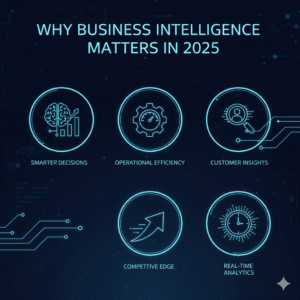How Much AI Data Is Made Every Minute?
While you read this sentence, millions of interactions powered by AI have happened all over the world. Artificial intelligence is creating data at a rate that is hard to understand, from simple voice commands to complicated financial transactions. Not only is this a lot of information, but it’s also a big change in how information is made, processed, and used that affects every part of business and society.
It’s very important to understand this new reality. AI makes so much data every 60 seconds that it is changing industries, creating new business opportunities, and presenting new problems. “Data Never Sleeps: AI Edition” is a groundbreaking new report that gives us an unprecedented look at this digital explosion. This post will break down the report’s key findings, exploring how much data AI is creating, what’s driving this growth, and what it means for our future. Business leaders can better prepare to use this change to their advantage and stay ahead of the competition if they know how big it is.
The “Data Never Sleeps: AI Edition” Report: A New Era of Data
For years, the “Data Never Sleeps” chart has given us a fascinating look at our digital lives by showing what happens online every minute. It counted everything, from Instagram posts to Google searches. For the first time, the 2025 “Data Never Sleeps: AI Edition” report looks closely at a new and important aspect: how much data AI makes.
This new report goes beyond looking at general internet use to look at the specific data that AI systems create and process. The method involves collecting anonymous data from a wide range of AI applications, such as generative AI platforms, recommendation engines, autonomous systems, and AI software used by businesses. By analyzing petabytes of information, the report quantifies the AI data footprint across various sectors, offering a clear picture of how AI is changing our world in real-time. The results are shocking and mark the beginning of a new era in the information age.
A Quick Look at AI in 60 Seconds
The numbers revealed in the “Data Never Sleeps: AI Edition” report paint a vivid picture of a world powered by AI. Every minute, a huge amount of data is created, far more than what was previously possible. The amount of data created by AI systems is growing at an exponential rate, even though general internet use is still growing.
The 2025 report says that in just 60 seconds, this is what happens:
- Generative AI makes: Generative AI models make more than 15 million new pieces of content every day, such as text, images, and code snippets.
- How Recommendation Engines Work: AI-powered recommendation algorithms on sites like Netflix and Spotify look at more than 200 million user interactions to make suggestions that are unique to each user.
- Voice Assistants Field: AI assistants like Siri and Alexa can understand and respond to more than 3 million voice commands. They can also control smart devices.
- Money AI Looks At: AI systems in finance handle more than $100 million in transactions and run fraud detection algorithms on each one.
- AI Scans in Healthcare: AI models in healthcare look at about 500,000 medical images and patient data records to help with diagnosis.
- Autonomous Systems Send: Drones and self-driving cars together collect more than 10 terabytes of operational data from their sensors.
These numbers show not only how much data is being made, but also how valuable it is. Each piece of data shows a choice, a guess, or a personalized interaction. This shows how much AI is already a part of our daily lives and important business tasks. Not too long ago, the question “how many people use Google in 60 seconds?” was the most important thing to talk about. Today, the main focus is on the intelligent systems that are processing that data.
Deep Dive: AI Data Generation by Sector
The growth of AI-generated data is not the same across all fields; some are using and adopting AI more than others. The “Data Never Sleeps: AI Edition” report gives a detailed look at how different industries are adding to the flood of data.
The AI-Powered Guardian for Finance
The financial services industry is the most advanced when it comes to using AI. Every 60 seconds, AI systems perform millions of critical tasks.
- Algorithmic Trading: AI algorithms make thousands of trades every second by looking at market data and making decisions right away. This high-frequency trading generates terabytes of data daily.
- Fraud Detection: AI models look through transaction data for every credit card swipe or online payment to find and flag any activity that seems fishy. This analysis in real time stops fraud worth billions of dollars every year.
- Personalized Banking: AI-powered chatbots and virtual assistants answer customer service questions, and other systems look at how people spend their money to give them personalized financial advice and product suggestions.
Healthcare: A Revolution in Diagnostics and Care
AI is changing the way patients do and the way healthcare works. The data generated is not just large in volume but also incredibly sensitive and complex.
- Medical Imaging Analysis: AI models look at MRIs, CT scans, and X-rays to find diseases like cancer faster and more accurately than human radiologists can. Every scan that is looked at adds to a growing dataset that makes these models even better.
- Predictive Analytics: Hospitals use AI to look at a patient’s electronic health records and guess when they will be admitted, when a disease will break out, and even how likely it is that a patient will develop a certain condition.
- Drug Discovery: AI helps pharmaceutical companies look at biological data and model how molecules interact with each other. This speeds up the process of finding and developing new drugs by a huge amount.
The Autonomous Future of Transportation and Logistics
The transportation industry is about to undergo a revolution led by self-driving cars.
- Self-Driving Cars: A self-driving car’s cameras, LiDAR, and radar sensors send out several terabytes of data every day. This information is necessary for safe driving and for making the vehicle’s decision-making algorithms better.
- Supply Chain Optimization: AI improves global supply chains by looking at data on weather, traffic, and demand to figure out when things will go wrong and how to best reroute shipments. This huge data ecosystem grows with each package tracked and each route planned.
- Smart Traffic Management: Cities are using AI to look at sensor data and traffic camera feeds to find the best times to change traffic lights, ease congestion, and make the roads safer for everyone.
What Caused the AI Data Explosion
What is causing this huge rise in data made by AI? There are many things that are connected that caused this digital big bang.
1. The rise of generative AI: The public release of powerful generative AI models has been a major factor. AI is now helping millions of people make text, images, code, and music, which is a huge new type of data.
2. Ubiquitous IoT Devices: The proliferation of Internet of Things (IoT) devices—from smart home assistants and wearables to industrial sensors—has created a constant stream of real-time data that AI systems are uniquely equipped to analyze.
3. More advanced machine learning models: Businesses can now get more value from their data in new ways thanks to the creation of more advanced and user-friendly machine learning algorithms. This creates a virtuous cycle: the more data that is analyzed, the smarter the AI models become, and the more data they are fed.
4. Cloud Computing Power: Cloud computing’s ability to grow and be cheap has made it possible for businesses of all sizes to store, process, and analyze the huge amounts of data needed to train and run powerful AI models.
5. Demand for Personalization: Customers now want experiences that are very tailored to them, from product suggestions to content delivery. Businesses are using AI to look at user data and meet these needs, which leads to even more data being created.
These factors are all coming together to make a perfect storm for data growth. AI is the main force shaping the answer to the question “how much data is generated every second?”

Implications and Future Trends: What’s Next?
The rapid rise of AI-generated data has big effects on businesses, technology, and society as a whole. Navigating this new landscape requires foresight and strategic planning.
For Companies
The ability to collect, analyze, and act on AI-generated data is becoming the single most important competitive differentiator. Companies that use AI in their operations will be able to work much more efficiently, get better insights into their customers, and come up with new ideas faster than their competitors. But this also makes it harder to store, protect, and manage data. Companies will need to spend money on strong data infrastructure and make clear rules about how to use AI in an ethical way.
For Tech
The explosion of data is pushing the limits of what we can do with technology. We will see faster progress in a number of fields:
- Edge Computing: To handle the huge amount of data and lower latency, it will be important to process it closer to where it comes from (on the device itself).
- Next-Generation Data Storage: To store petabytes and even exabytes of data quickly and cheaply, new storage solutions will be needed.
- AI-Optimized Hardware: The need for more processing power will lead to the creation of specialized chips (GPUs, TPUs) that are made just for AI tasks.
For Society
The effects on society will be very big. AI could help us solve some of our biggest problems, like finding a cure for diseases and fighting climate change. But it also makes us think about important issues like privacy, bias in algorithms, and the future of work. We need to have a thoughtful conversation as a society to come up with rules and moral guidelines that make sure AI is built and used in a way that is good for everyone. AI will have a huge impact on the “Data Never Sleeps” landscape from now until 2025 and beyond.
Get Your Business Ready for the Future of AI
The “Data Never Sleeps: AI Edition” report gives business leaders more than just interesting numbers; it tells them what they need to do. It is no longer an option to understand and use the power of AI-generated data; it is necessary for survival and growth. Companies that are data-driven, flexible, and in line with the strategic goals of artificial intelligence will do well in this new era.
Business Kiwi is an expert at helping businesses make sense of this complicated world. Our team of experts can help you build a data-driven culture and put AI solutions into place that will really help your business.
Are you ready to find out how your business can use AI to its advantage? Call us today to set up a meeting to talk about your specific problems and chances. Let’s work together to build your future.






